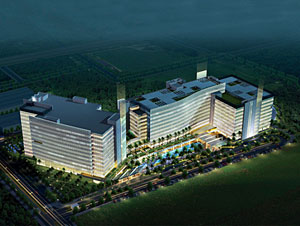'New' India Bows to Newer Realities
In the past five years, as India’s hunger for glass-encased IT parks and marble-swathed gated communities appeared insatiable, architects designed supersize projects dreamed up by Indian developers. Then the money disappeared. As the global economic crisis has snowballed, the country’s banks have turned skittish.

“The first to get hit are large projects,” says Mohit Gujral, whose firm, Design Plus, does lots of big projects and has had to lay off a quarter of its 140 employees. Design Plus has worked on some of New Delhi’s swankiest mega-malls and with Singapore-based Kerry Hill Architects on the city’s first Amanresorts hotel. As business slows down, Gujral says, “You look at projects and scales you may not have considered earlier.”
The Survam Knowledge Park, a 15-acre site in the tech suburb of Gurgaon, is an example of a “new India” project bowing to newer realities. Excavation began months ago on the $115 million project, but work has now paused. “They are revisiting the project,” said Anil Rawat, India managing director for Canada’s B+H Architects, which worked on the design and opened an office in the country with a local partner 15 months ago.
Smaller firms that work directly with users have been less affected. “They’re still fitting out the same square footage, but at a reduced budget,” said Rahoul Singh, whose firm, Rahoul Singh Design Associates, counts on residences funded by private wealth for half its workload.
Some major projects are going ahead, but with different customers in mind. B+H's Rawat said that townships the firm is designing around the northern city of Haridwar were planned originally to include apartments of 950 square feet as well as villas three or four times that size. Now there will likely be fewer villas and more of the smaller, cheaper apartments, as "affordable housing" becomes the new mantra for developers.
Indian cities face a shortage of 25 million housing units, mostly for low-income families. But most apartments advertised in major cities until last year cost upwards of 60,000 dollars—75 times India's average annual income. "There were never enough end-users for that and there were never going to be," said Manit Rastogi, of the mid-sized firm Morphogenesis, who says new projects will now be driven by real demand rather than speculative investment.
Rastogi has seen about a third of his projects shut down, but is optimistic about making up for lost work in areas that still face a shortfall—such as mid- and low-end housing, schools, and healthcare facilities. The firm is designing a university of 2.5 million square feet in a Delhi suburb. “There are real projects to be delivered,” he said. “India is a developing country. We still have a shortage of housing. We have a shortage of true office space. We have a shortage of just about everything.”
